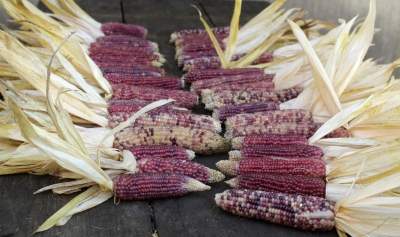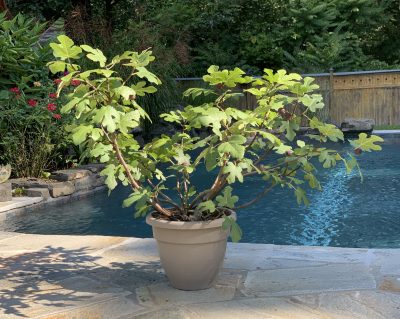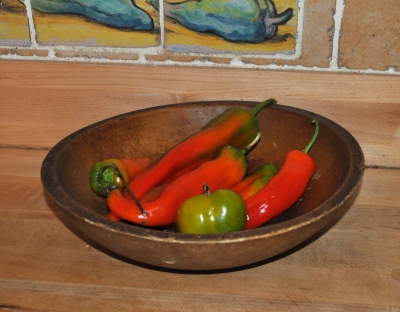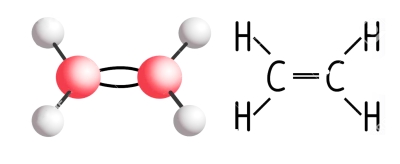COLORFUL EARS, AND TASTY, TOO
/2 Comments/in Vegetables/by Lee ReichPopcorn Traditions
I was surprised at the different colors of my ears this fall — popcorn ears, that is. ‘Pink Pearl’ popcorn lived up to its name, yielding short ears with shiny, pink kernels. Peeling back each dry husk of ‘Pennsylvania Dutch Butter Flavored’ popcorn revealed rows of creamy white kernels. The surprise came from some ears from either bed whose kernels were multi-colored, each in a different way, with some kernels mahogany-red, some pale pink, some dark pink, and some lemon yellow.
I plan to bring some of these popped kernels to Thanksgiving dinner, just as Native American chief Massasoit’s brother, Quadequina, brought along a sack of popped popcorn to the first Thanksgiving feast almost four centuries ago.
Popcorn predates that first Thanksgiving in America by thousands of years. Kernels have been found in the remains of Central American settlements of almost 7000 years ago. The Quichas of Peru and the Aztecs of Mexico grew red, yellow, and white popcorns. Even after that first Thanksgiving dinner, popcorn was eaten by settlers in the Northeast as a breakfast staple with milk and maple sugar, or floated on soup (very good!). Beginning in the last century, movie and television viewing caused a resurgence in popcorn consumption.
FORWARD, WITH FIGS
/2 Comments/in Fruit/by Lee ReichPotted Figs, but First a “Haircut”
Temperatures here have dipped into the lower 20s a few nights and still dip readily to around freezing, which might lead some of you to believe I have been neglectful of my fig trees, which are still outdoors. Not so! They are subtropical plants that can take temperatures down into the ‘teens.
Today I moved all my potted figs to their winter home. As I wrote in my book Growing Figs in Cold Climates, fig, being a subtropical plant, likes cold winters, just not those that are too, too cold. My plants went either into my basement, where winter temperatures hover in the 40s, or into my walk-in cooler (also used for storing fruits and vegetables) whose temperature is nailed at 39°.

One of my friend Sara’s figs in summer
I always prune my figs before nestling them into the basement or the cooler. Then they can be carried without errant stems slapping my face, and the pots can be stored without undo elbowing neighboring potted figs.
IN WHICH A SMALL GAS MOLECULE HAS A BIG EFFECT
/0 Comments/in Gardening/by Lee ReichIt’s a Gas
Ethylene is so simple. It’s a gas made up of merely two atoms of carbon and four atoms of hydrogen. Simple gases are generally not the kinds of molecules that make plant hormones which, like human hormones, are generally complex molecules with dramatic effects at extremely low concentrations. Nonetheless, ethylene is a plant hormone. I thought of ethylene as I sunk my teeth into the last garden-fresh peppers of the season a couple of weeks ago. Note that I wrote “fresh,” not “fresh-picked.”
Those peppers were picked week or two before being eaten. I picked any green peppers showing the slightest hints of red, then spread them out on a tray. Many gardeners do this with tomatoes. I like peppers a lot more than tomatoes so only occasionally try to prolonging the season of fresh tomatoes.
It’s ethylene that’s responsible for the transformations from unripe to ripe. Ethylene is produced naturally in ripening fruits, and its very presence — even at concentrations as low as 0.001 percent — stimulates, in turn, further ripening. The ethylene given off by ripe apples can be used to hurry along ripening of peppers or tomatoes, by placing an apple in a closed bag with them.

If the fruits are left too long in the bag, ethylene will stimulate ripening which will stimulate more ethylene which will stimulate even more ripening which will stimulate more ethylene which will stimulate still more ripening, ad infinitum, until what is left is a bag of mushy, rotten fruit. Apples can do this to each other, so one rotten apple really can spoil a whole barrel of them.

